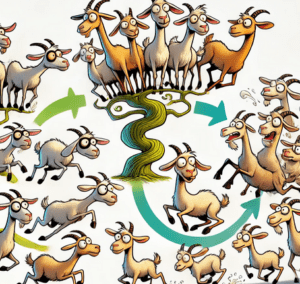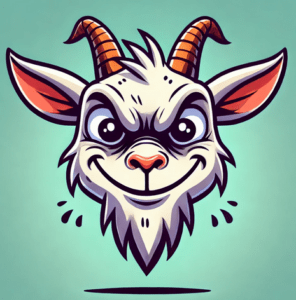Goats: The Good, the Bad, and the Cheesy!
What Are Goats?
Goats are domesticated animals that have been lovingly bred and raised by humans for thousands of years. Recognized for their versatility, these remarkable livestock can thrive in a multitude of environments and serve various purposes, including milk production, meat, fiber, and even as pack animals. As ruminants, goats possess a four-chambered stomach that enables them to efficiently digest tough plant materials, making them particularly well-suited for grazing on marginal lands where other livestock may struggle.
With over 300 recognized breeds worldwide, goats come in an array of sizes, colors, and temperaments, allowing them to adapt to different farming and homesteading needs. This diversity provides options for those looking to integrate goats into their operations, whether for companionship, agricultural contributions, or sustainable practices.
While this page offers an overview of goats, our intention is to inspire thoughtful consideration of both the benefits and challenges we have encountered in recent years. It is vital to assess your local laws, environmental conditions, facilities, and available resources before making a commitment. In some cases, smaller breeds, such as rabbits or quail, may be more suitable than larger goats, depending on your specific circumstances.
We encourage you to reflect on your natural environment, your goals, and the potential impacts of your choices. If you have insights or experiences to share that may enhance this discussion, please don’t hesitate to reach out. Together, we can learn and grow in our understanding of these wonderful animals.

1. Why We Prefer Goats Over Sheep or Cattle?
Goats present several advantages over sheep and cattle, particularly for small-scale farmers and homesteaders. Their smaller size makes them generally more manageable, and they are renowned for their hardiness and adaptability. Unlike cattle, which require extensive grazing lands, goats can thrive in compact spaces and are exceptional foragers, capable of consuming a diverse range of plants, including shrubs and weeds that other livestock may avoid.
Moreover, goats are typically less susceptible to certain diseases that affect sheep, such as foot rot, making them a resilient choice for farming. Their engaging and curious personalities add an element of enjoyment to farm life, making them delightful companions as well as productive animals.
With the ability to produce milk, meat, and fiber, coupled with relatively low maintenance requirements, goats prove to be a versatile and valuable addition to any farming operation. By choosing goats, you can enhance both the functionality and enjoyment of your homestead.
2. Why Small Goats are ‘just as good’
While some may argue that small goats do not produce enough milk or meat compared to larger breeds, this perspective overlooks several key factors that highlight their true value. Nigerian Dwarf goats, for example, are renowned for their high butterfat content, often exceeding that of many larger dairy breeds when comparing apples to apples (or litres per goat kilograms). This rich milk not only enhances the quality of dairy products but also provides a significant nutritional benefit. In terms of meat, the protein quality and flavor from these smaller goats can rival that of larger animals, offering a leaner alternative that is both healthful and delicious. And as pets? Well, a smaller animal is more handlable, treatable, controllable and easier to inspect and enjoy from up close.
Moreover, the smaller size of these goats allows for increased stocking densities on land, enabling farmers to raise larger numbers without overwhelming natural resources. This efficient use of space means that small goats can be integrated into diverse farming systems with a minimal ecological footprint. By producing goats in greater numbers, farmers can meet their production needs while promoting sustainability and reducing the strain on the environment. Ultimately, the advantages of small goats extend beyond mere quantity; they offer a combination of quality, practicality, and sustainability that can exceed the contributions of larger livestock. If the veld loves them, so can we.
3. The History of the Nigerian Dwarf Goat
The Nigerian Dwarf Goat originated from the West African dwarfs, and initially exported primarily as zoo exhibits. However, their small size, friendly nature, and impressive milk production quickly garnered the interest of small farmers and hobbyists alike. Over time, selective breeding has led to the establishment of the Nigerian Dwarf Goat as a recognized breed with distinct characteristics. This goat now roams homesteads and farms in many parts of the world, including here in South Africa.
These goats are especially prized for their ability to produce a substantial amount of high-butterfat milk relative to their size, making them an ideal choice for homesteaders, small-scale farmers, and small dairy operations. Despite their petite stature, Nigerian Dwarf goats boast a hardy constitution and remarkable adaptability, thriving in a variety of climates and conditions. Their resilience, combined with their productive capabilities, makes them a valuable addition to any farming endeavor.
4. The Advantages of the Nigerian Dwarf Goat
Nigerian Dwarf Goats present numerous advantages, making them an appealing choice for small-scale farming. One of their most notable benefits is their milk production. Despite their small size, they can yield between 500 ml to 1.5 liters of milk per day, with a butterfat content ranging from 6% to 10%. This results in rich, creamy milk that is excellent for cheese, yogurt, and other dairy products. Though they produce less milk than larger goats, this can facilitate easier management and reduce the risk of issues like mastitis and discomfort.
Their compact size also translates to reduced space and feed requirements, making them more economical to maintain. Friendly and gentle in temperament, Nigerian Dwarf Goats are easy to handle, making them suitable for families and novice goat keepers. Their playful and engaging personalities often make them favorites among livestock, serving as great companions, permaculture workers, invasive brush-clearers, lawnmowers, and reliable sources of meat and milk.
Additionally, their smaller stature allows for easier handling, even for those with smaller frames or limited mobility. Despite their size, they produce a significant amount of meat, matching or exceeding the output of other breeds. Their browsing nature leaves minimal damage to the delicate Karoo veld, and we have observed an increase in native grasses as a result.
Nigerian Dwarf Goats exhibit a variety of colors and shapes, providing flexibility in breeding direction and herd development. While not exclusive to this breed, they are also known for frequently yielding twins and triplets. Their smaller size requires considerably less dry matter intake, reducing feeding costs and simplifying the process of growing your own feed. They are easier to contain with proper fencing techniques, including electric training, and tend to return easily to their home base with regular treats.
Finally, these goats produce an abundance of valuable manure, enriching your natural systems and gardens, further enhancing their appeal as a sustainable farming choice.
5. The Disadvantages of the Nigerian Dwarf Goat
 While Nigerian Dwarf Goats offer numerous benefits, there are some drawbacks to consider (as with most things in life). Their small size, while generally advantageous, can make them more vulnerable to predators such as dogs, jackals, and other wildlife. As a result, secure fencing and additional protection measures are essential to safeguard their wellbeing, especially overnight. With that said, we have never lost a goat or kid to predators.
While Nigerian Dwarf Goats offer numerous benefits, there are some drawbacks to consider (as with most things in life). Their small size, while generally advantageous, can make them more vulnerable to predators such as dogs, jackals, and other wildlife. As a result, secure fencing and additional protection measures are essential to safeguard their wellbeing, especially overnight. With that said, we have never lost a goat or kid to predators.
Their energetic and curious nature can also lead to escape attempts and mischievous behavior if they are not adequately entertained or contained. Fortunately, they respond well to training and scheduling, which can help mitigate these tendencies. While larger goats have the same tendencies, a small goat can slip through a small space without effort.
Additionally, while Nigerian Dwarf Goats are generally hardy, they can be prone to certain health issues if not cared for properly. Each goat requires space—ideally between 20 and 25 square meters—and special attention should be given to isolation between bucks and does, as bucks will often attempt to mate with pregnant does. This need for separation is particularly notable given their size and behavior patterns.
Bucks are known for their strong odors, which can test your patience. Physical separation and having wethers (castrated males) to keep them company is advisable. To maintain a healthy and social herd, a minimum of two does is recommended, along with one wether for the buck, resulting in at least four goats and around 100 square meters of space to roam during the day, if not open browsing areas are available.
A strong, electrified fence is ideal for keeping them contained, although unexpected encounters with wildlife, such as baboons or jackals, can disrupt their security. While they do not typically wander far, they can still venture into gardens or areas where their presence is not desired. Due to their size, owners may mistakenly perceive them as less troublesome, but they can exhibit the same mischievous behaviors as larger goats.
If they are not allowed to roam on natural veld and rocky terrain, regular care will be necessary for their hooves and overall health. These maintenance needs, while not unique to Nigerian Dwarfs, are easy to overlook due to their petite stature.
